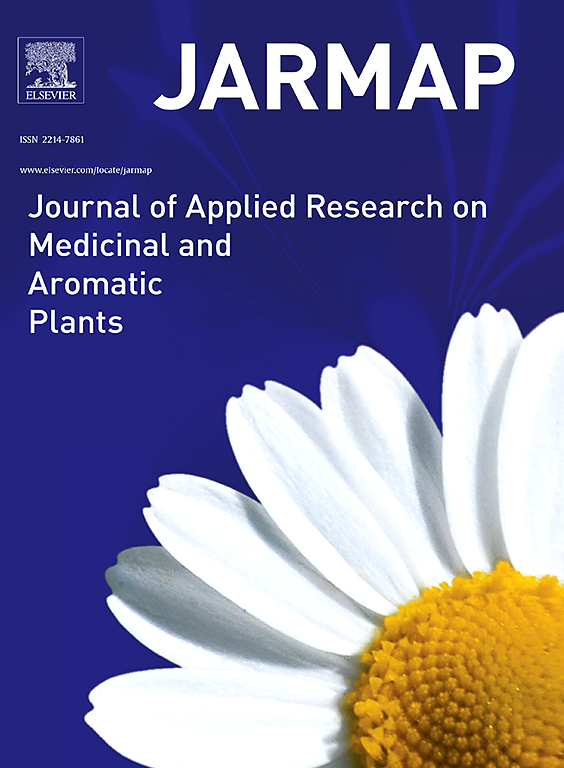Species discrimination of Fritillaria Bulbus using PCR-CRISPR/Cas12a-based nucleic acid detection
IF 3.6
2区 农林科学
Q1 PLANT SCIENCES
Journal of Applied Research on Medicinal and Aromatic Plants
Pub Date : 2024-10-09
DOI:10.1016/j.jarmap.2024.100589
引用次数: 0
Abstract
Fritillaria Bulbus (FB) is a traditional Chinese herbal medicine known for its efficacy in relieving coughs and alleviating asthma. It is frequently used in conjunction with other Fritillaria species due to their highly similar morphological characteristics. Given their considerable medicinal and economic value, convenient and accurate methods for identifying these herbal medicines are essential. This study introduces a nucleic acid detection method that integrates PCR amplification of the target region of nuclear ribosomal DNA with CRISPR/Cas12a mediated trans-cleavage of a fluorescent reporter. This method distinguishes between the two most commercially valuable species of FB, specifically Fritillaria Cirrhosa Bulbus (FCB) and Fritillaria Ussuriensis Bulbus (FUB). A conserved fragment of nuclear ribosomal DNA was chosen as the target sequence for designing crRNAs specific to each species. Both crRNAs exhibit high sensitivity in detecting amplified genes, with a detection limit of 3.0 ng/μl. No cross-reactivity was detected with non-target species, indicating high specificity. The practicality of this method was validated through the analysis of standard medicinal materials and real-world samples. Compared to DNA barcoding, this method exhibited superior capability in detecting mixed samples, thereby establishing a benchmark for the application of CRISPR/Cas-based nucleic acid detection in verifying the authenticity of traditional Chinese medicinal materials.
利用基于 PCR-CRISPR/Cas12a 的核酸检测技术鉴别 Fritillaria Bulbus 的物种
Fritillaria Bulbus(FB)是一种传统中药材,因其止咳平喘的功效而闻名。由于其形态特征高度相似,它经常与其他青风藤品种一起使用。鉴于这些中药材具有相当高的药用价值和经济价值,因此必须采用方便、准确的方法来鉴定这些中药材。本研究介绍了一种核酸检测方法,它将核核糖体 DNA 目标区的 PCR 扩增与 CRISPR/Cas12a 介导的荧光报告物反式裂解整合在一起。这种方法可以区分两种最具商业价值的 FB,特别是 Fritillaria Cirrhosa Bulbus (FCB) 和 Fritillaria Ussuriensis Bulbus (FUB)。我们选择了核核糖体 DNA 的一个保守片段作为目标序列,以设计出针对每个物种的特异性 crRNA。两种 crRNA 在检测扩增基因方面都表现出较高的灵敏度,检测限均为 3.0 ng/μl。没有检测到与非目标物种的交叉反应,表明其特异性很高。通过对标准药材和实际样品的分析,验证了该方法的实用性。与DNA条形码相比,该方法在检测混合样品方面表现出更强的能力,从而为基于CRISPR/Cas的核酸检测在验证中药材真伪方面的应用树立了标杆。
本文章由计算机程序翻译,如有差异,请以英文原文为准。
求助全文
约1分钟内获得全文
求助全文
来源期刊

Journal of Applied Research on Medicinal and Aromatic Plants
Pharmacology, Toxicology and Pharmaceutics-Drug Discovery
CiteScore
6.40
自引率
7.70%
发文量
80
审稿时长
41 days
期刊介绍:
JARMAP is a peer reviewed and multidisciplinary communication platform, covering all aspects of the raw material supply chain of medicinal and aromatic plants. JARMAP aims to improve production of tailor made commodities by addressing the various requirements of manufacturers of herbal medicines, herbal teas, seasoning herbs, food and feed supplements and cosmetics. JARMAP covers research on genetic resources, breeding, wild-collection, domestication, propagation, cultivation, phytopathology and plant protection, mechanization, conservation, processing, quality assurance, analytics and economics. JARMAP publishes reviews, original research articles and short communications related to research.
 求助内容:
求助内容: 应助结果提醒方式:
应助结果提醒方式:


